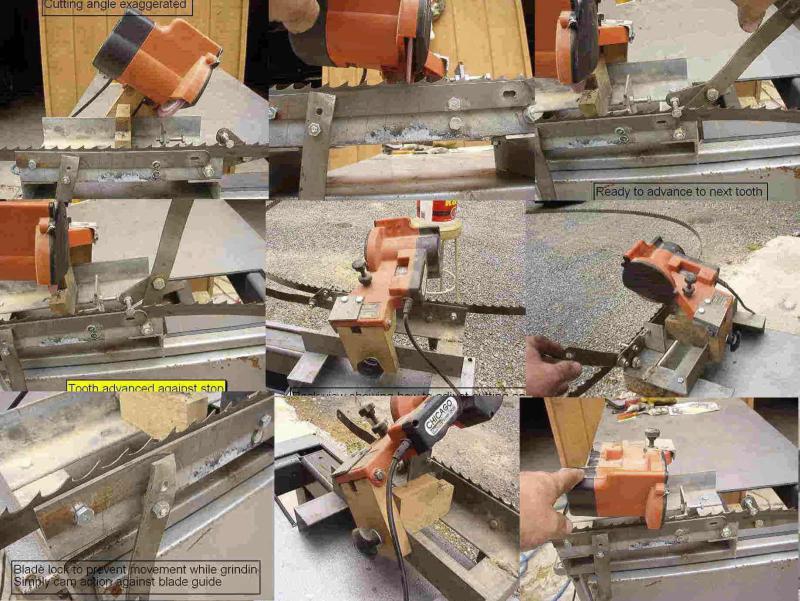Q.
I have someone who wants me to cut a bunch of treated timbers (6-inch by 16-inch creosote-covered fir) into 2-by-4 and 2-by-6 stuff. The timbers look like railroad ties on steroids.
Is there anything I should know before running my bandmill through this stuff?
One last note: Be prepared to go through a bunch of blades if you have a lot of cutting to do. If these timbers were treated with "creosote-coal tar solution" as opposed to "coal tar creosote," they will have lots of solids -- technically "matter insoluble in xylene."
Lots of older stuff, especially, was treated with CCTS instead of CTC.
Creosote penetrates deeply into and remains in the pressure-treated wood for a long time. Exposure to creosote may present certain hazards. Therefore, the following precautions should be taken in handling the treated wood.
Handling Precautions
Dispose of treated wood by ordinary trash collection or burial. Treated wood should not be burned in open fires or in stoves, fireplaces, or residential boilers because toxic chemicals may be produced as part of the smoke and ashes. Treated wood from commercial or industrial use (e.g., construction sites) may be burned only in commercial or industrial incinerators or boilers in accordance with state and Federal regulations.
Avoid frequent or prolonged inhalation of sawdust from treated wood. When sawing and machining treated wood, wear a dust mask. Whenever possible, these operations should be performed outdoors to avoid indoor accumulations of airborne sawdust from treated wood.
Avoid frequent or prolonged skin contact with creosote-treated wood; when handling the treated wood, wear long-sleeved shirts and long pants and use gloves impervious to the chemicals (for example, gloves that are vinyl coated).
When power-sawing and machining, wear goggles to protect eyes from flying particles.
After working with the wood, and before eating, drinking, and the use of tobacco products, wash exposed areas thoroughly.
If oily preservatives or sawdust accumulate on clothes, launder before reuse. Wash work clothes separately from other household clothing.
Coal tar pitch and coal tar pitch emulsion are effective sealers for creosote-treated wood-block flooring. Urethane, epoxy, and shellac are acceptable sealers for all creosote-treated wood.
The wood must not have been Douglas fir; it was very soft. I started with a used blade because I expected to hit metal or rocks but I didn't, and completed the job quite well with the one blade. The beams had very little tar buildup on the outside but the penetration looked very deep.
We returned all the scraps to the customer. The sawdust was mixed with a considerable volume of oak sawdust and spread across the log lot.
After sawing, we all took a shower and put on fresh clothes. Having purposely chosen to wear worn-out overalls and an old shirt, I disposed of my outside clothes.
That evening my face, neck and arms itched like the latter stages of sunburn and I had a headache. It may not have been related, but that night I developed some intestinal problems that lasted for three days. I had the most contact with the sawing. The others involved didn't complain of symptoms.
Soon after sawing, we called the customer to come and get the re-sawn beams, as they really smelled bad after being sawn. He came that evening and picked them up. Unfortunately, they were back before dark with two more to split and two more to make 2-by-8s out of. We agreed to saw these but no more.
Treated wood saves trees. Think how many more trees would have to be harvested if everything that is built of treated timber had to be replaced every few years. Also, alternative materials such as steel, aluminum, and concrete consume up to 15 to 20 times more energy in the manufacturing process. That means 15 to 20 times more air pollution from coal burning or 15 to 20 times more radioactive waste from nuclear generation.
As far as disposal goes, the Consumer Info Sheet I posted explicitly states that appropriate disposal for creosote treated wood is by ordinary trash collection and disposal means. The CIS was approved by the U.S. Environmental Protection Agency, and I can guarantee you that the EPA didn't cut some back door deal with the industry because they would like nothing more than to see creosote treating plants put out of business.
Comment from contributor J:
I have been sawing creosote lumber for the last 10 years. I work in a landfill in a port city, and thousands of poles are dumped here every year from various places. We sawmill about 30 poles per day on average. All of the waste including the sawdust is recovered and dumped over a lined landfill. We are saving extremely valuable space, and have developed a lucrative buissness.
Horse farmers love creosote fencing - it will not rot and horses will not crib it. We use a mill with a remote, under a pole barn. We have learned to stay out of the flying dust, and we saw only in cooler weather when we are well clothed. I consider this a win-win business. It saves high dollar landfill space and we’re making good money for our product. Every pole I saw saves a tree from being cut down.
